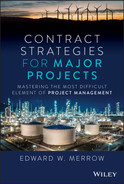Major Projects are Delayed by Months or Years, and Cost Millions More Than Budgeted, Because of Common Mistakes Made at the Contracting Stage Key Principles of Contracting for Major Projects: Merrow also explains: The strategic advice in this book is designed for owners and contractor project managers, team members and supply chain, executives, and other business leaders involved in major projects. It's also an indispensable resource for engineers, leaders of industrial firms, bankers, and academics studying the messy realities of the construction and engineering industries.
Organizations that invest huge amounts of capital in major building/industrial projects almost never do the engineering and building themselves. They hire engineering and construction contractors to do it for them. Unfortunately, selecting contractors and negotiating the terms of a major project is one of the most difficult aspects of project management...and organizations waste billions of dollars and "bake in" months or years of delay by doing it wrong. Contracting is also the area of project management that is most prone to firmly held opinions unencumbered by any facts. We intend to remedy that situation with this book. Drawing on a properietary detailed database of over 1100 major projects, the world's leading industrial engineering project consultant, Ed Merrow explains:
Table of Contents
- Cover
- Title Page
- Copyright
- Dedication
- Acknowledgments
- Introduction: What This Book Is Aboutintroduction
- CHAPTER 1: Ten Key Principles of Contracting
- CHAPTER 2: Data, Methods, and Nomenclature
- CHAPTER 3: Contracting and Project Outcomes: The Common Strategies
- CHAPTER 4: Exploring Why They Work the Way They Do
- CHAPTER 5: The Unusual EPC Lump‐Sum Strategies
- CHAPTER 6: Collaborative and Relational Contracting Strategies
- CHAPTER 7: Prequalification
- CHAPTER 8: The Use of Supplemental Incentives
- CHAPTER 9: It's All About Risk
- CHAPTER 10: Who Should Control Contracting Strategy?
- CHAPTER 11: The Effects of Scale
- CHAPTER 12: Toward Fair, Balanced, and Smart
- Appendix: Description of Independent Project Analysis, Inc.
- Glossary
- Index
- End User License Agreement
